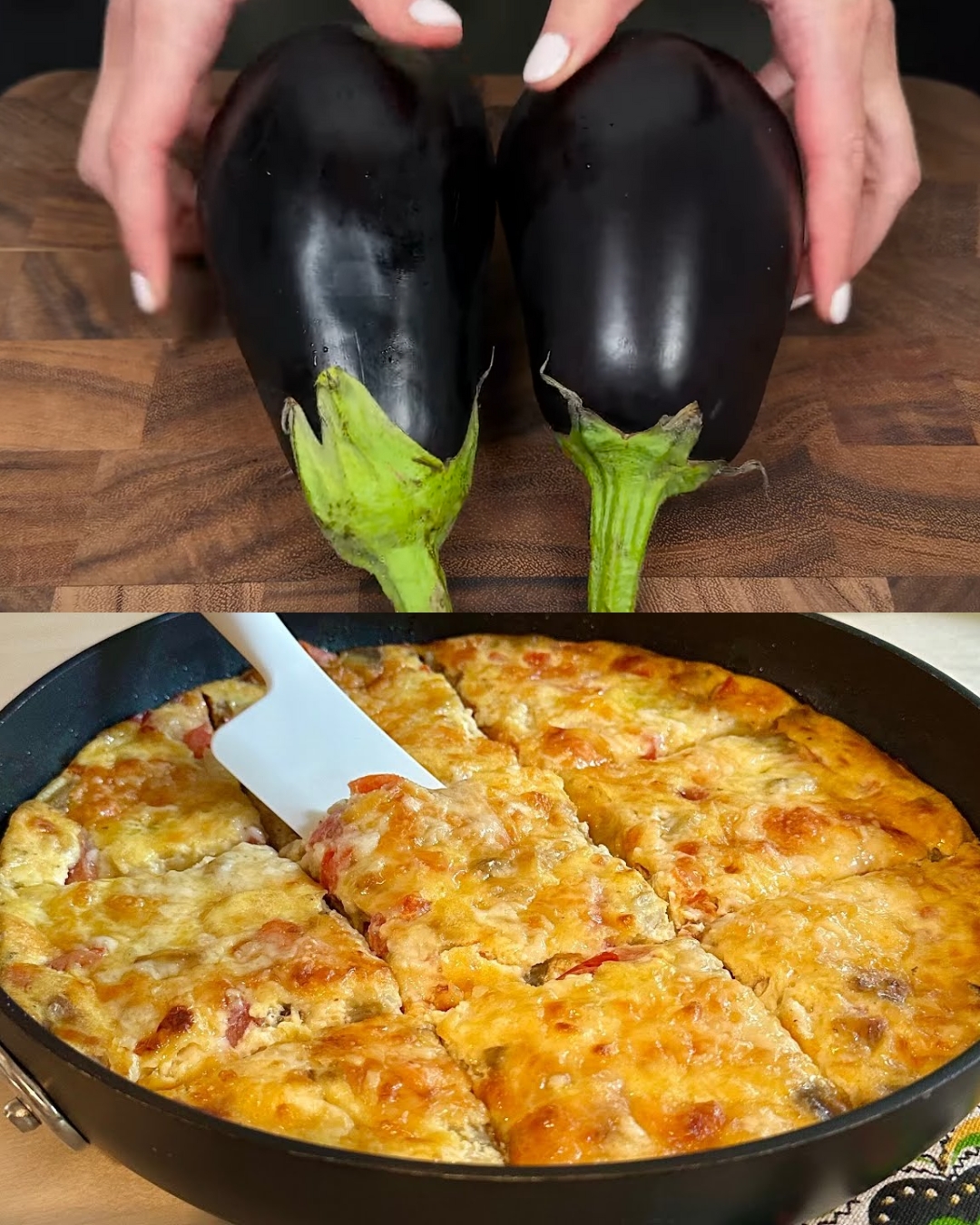This vegetable and cheese egg casserole is a perfect dish to serve for breakfast, brunch, or even a light dinner. Packed with nutritious vegetables like eggplant, bell pepper, and tomatoes, this casserole combines the goodness of eggs and cheese for a hearty, flavorful meal. The mozzarella and Parmesan cheeses melt beautifully over the vegetables, adding richness and depth to the dish. It’s easy to make and can be prepared in less than an hour, making it a convenient and satisfying option for any meal. Whether you’re cooking for yourself or feeding a family, this casserole will be a hit!
Preparation Time
- Prep time: 15 minutes
- Cook time: 30 minutes
- Total time: 45 minutes
- Servings: 4
Ingredients
- 4 eggs
- 50 ml milk (about 1/4 cup)
- Salt and pepper, to taste
- 1 eggplant, peeled and cut into cubes
- 1 paprika (bell pepper), diced
- ½ onion, chopped
- 2 tablespoons olive oil
- 1 teaspoon Italian herbs
- ½ teaspoon dried garlic
- 3 small tomatoes, chopped
- 100g (1 cup) mozzarella cheese, shredded
- 2 tablespoons Parmesan cheese, grated
- Oil for frying
Directions
Prepare the Eggs:
- In a bowl, beat 4 eggs with 50 ml of milk. Season with salt and pepper to taste, and set aside.
Prep the Vegetables: 2. Peel the eggplant and cut it into cubes. Dice the bell pepper and chop the onion.
Sauté the Vegetables: 3. Heat olive oil in a pan over medium heat. Add the cubed eggplant, diced bell pepper, and chopped onion. Season with Italian herbs, dried garlic, salt, and pepper. Sauté the vegetables until they are tender and cooked through, about 10-12 minutes.
Add the Tomatoes: 4. Stir in the chopped tomatoes and cook for another 2 minutes, then remove from heat.
Assemble the Casserole: 5. Grease a baking dish with a bit of oil. Spread the sautéed vegetables evenly in the dish. Pour the egg mixture over the vegetables and top with shredded mozzarella cheese and grated Parmesan.
Bake: 6. Preheat the oven to 200°C (400°F). Place the casserole in the oven and bake for 30 minutes, or until the top is golden and the eggs are set.
Serve: 7. Remove from the oven, let it cool for a few minutes, and serve warm.
Serving Suggestions
- Serve with a side of garlic bread or crusty bread for a complete meal.
- Pair with a green salad for a light and balanced lunch.
Nutritional Facts (Per Serving)
- Calories: 250 kcal
- Carbohydrates: 12g
- Protein: 15g
- Fat: 18g
- Fiber: 4g
- Sugar: 5g
- Sodium: 450mg
The Origins and Popularity of Egg Casseroles
Egg casseroles are a staple in many households, especially for breakfast or brunch, due to their simplicity and versatility. This type of dish has been around for centuries, but its modern popularity grew in the mid-20th century as more people started looking for quick, make-ahead meals that could feed a family or guests. The combination of eggs, cheese, and vegetables or meat makes egg casseroles an all-in-one dish that is both satisfying and nutritious.
The dish is particularly popular in Western cuisine, with variations of it being found across the United States, Europe, and even parts of Asia. Depending on the region, egg casseroles can be made with a variety of ingredients, including potatoes, sausage, bacon, or vegetables. This vegetable and cheese egg casserole is a lighter take on the classic, making it a great option for those seeking a healthy and filling meal without sacrificing flavor.
Why You’ll Love This Recipe
This vegetable and cheese egg casserole is not only delicious but also packed with flavor and nutrition. The soft eggs, tender vegetables, and melted cheese combine to create a dish that is both satisfying and wholesome. The addition of mozzarella and Parmesan cheese adds a deliciously creamy texture and a savory, rich taste, while the combination of Italian herbs and dried garlic infuses the casserole with an aromatic depth of flavor.
The best part about this recipe is how customizable it is. You can swap out the vegetables for your favorites or whatever you have on hand—zucchini, mushrooms, or spinach all make great additions. Plus, the dish is simple to prepare, and you can bake it ahead of time for an easy meal later. Whether you’re feeding a crowd or just looking for a comforting weeknight dinner, this casserole is a great choice.
Health Benefits of This Recipe
This vegetable and cheese egg casserole offers a variety of health benefits, thanks to the nutrient-dense ingredients. Eggs provide high-quality protein, essential vitamins, and minerals such as vitamin B12, vitamin D, and choline, which supports brain health and function. The inclusion of vegetables like eggplant, bell pepper, and tomatoes adds fiber, antioxidants, and vitamins A and C, which are beneficial for immune health and skin.
Mozzarella and Parmesan cheese provide a good source of calcium, which supports bone health, as well as protein and healthy fats. Olive oil adds heart-healthy monounsaturated fats, which are known to help reduce inflammation and support overall cardiovascular health. By using whole, fresh ingredients, this casserole is a great way to enjoy a meal that’s both nutritious and delicious.
Serving Suggestions of This Recipe
This vegetable and cheese egg casserole is a versatile dish that can be served in a variety of ways:
- For Brunch: Pair it with fresh fruit, yogurt, and a light smoothie for a complete brunch spread.
- For Lunch or Dinner: Serve it alongside a green salad or roasted vegetables for a balanced and filling meal.
- With Bread: A side of garlic bread or crusty baguette is the perfect accompaniment to soak up any extra egg mixture.
- For Meal Prep: This casserole works well for meal prep, as it can be made ahead of time and enjoyed throughout the week.
Tips
- Vegetable Substitutions: Feel free to swap out the vegetables for whatever you have available, such as spinach, mushrooms, zucchini, or even broccoli.
- Use Fresh Herbs: If you have fresh herbs like basil, thyme, or rosemary, use them instead of dried Italian herbs for a more vibrant flavor.
- Make it Spicy: For a little kick, add a pinch of chili flakes or some hot sauce to the egg mixture.
- Storage: Leftovers can be stored in an airtight container in the refrigerator for up to 3 days. You can reheat it in the microwave or oven.
Variations to Try
- Add Meat: If you prefer a non-vegetarian version, you can add cooked sausage, bacon, or ham to the casserole for added protein and flavor.
- Make it Dairy-Free: Use dairy-free cheese and substitute olive oil for the butter to make this recipe suitable for those avoiding dairy.
- Add Grains: You can also incorporate cooked quinoa, rice, or even couscous to make the casserole heartier and more filling.
Conclusion
This vegetable and cheese egg casserole is a perfect dish for anyone looking for a healthy, delicious, and easy-to-make meal. Packed with fresh vegetables, rich cheese, and eggs, it’s a satisfying dish that will keep you full and energized. Whether you’re making it for breakfast, brunch, or dinner, this casserole is sure to be a favorite. Plus, with its versatility, you can customize it to suit your tastes and dietary preferences. Give this recipe a try, and enjoy a wholesome, flavorful meal!
Frequently Asked Questions
-
Can I use frozen vegetables for this casserole?
Yes, frozen vegetables can be used in place of fresh ones. Just make sure to thaw and drain them before adding them to the casserole. -
Can I make this dish ahead of time?
Absolutely! You can prepare it ahead of time and store it in the fridge. Simply bake it when you’re ready to serve. -
Can I use different cheeses?
Yes, you can substitute the mozzarella and Parmesan with any cheese you like, such as cheddar, gouda, or feta. -
How do I make this casserole spicier?
Add some chili flakes, diced jalapeños, or hot sauce to the egg mixture for extra heat. -
Can I make this casserole vegetarian?
Yes, this recipe is already vegetarian, but you can add more vegetables like spinach, mushrooms, or zucchini for additional flavor and texture. -
Can I use a different kind of oil for frying?
Yes, you can use other oils like coconut oil or avocado oil in place of olive oil for sautéing the vegetables. -
How long does this casserole last?
Leftovers can be stored in the refrigerator for up to 3 days. Reheat in the oven or microwave before serving. -
Can I add potatoes to this casserole?
Yes, diced and pre-cooked potatoes can be added to the casserole for a heartier dish. -
Can I make this recipe gluten-free?
Yes, this recipe is naturally gluten-free. Just make sure that the cheese and other ingredients you use are gluten-free. -
Can I freeze this casserole?
Yes, you can freeze the casserole before baking. Just cover it tightly with plastic wrap or foil and bake it when ready.

